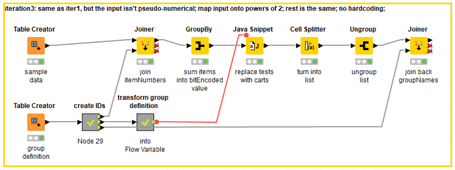Hi @Thyme ,
Yes, you are right that we have 30 unique tests from the “Grouping of tests and 42 total. Yeah your initial solution can work but in that case we need to use normal strings instead if test1,test2 - if you can guide me how to use normal strings instead of test1,test2 … and cart1, cart2… we can use that logic.
or
else we can use below logic as well
-if the array contains “kiwi”- then instead of checking all the values for fruits group , we can say that “fruit” groups is possible
-and if the array contains “garlic”- then instead of checking all the values for vegetable group , we can say that “vegetable” groups is possible
-and if the array contains “dark”- then instead of checking all the values for chocolate group , we can say that “chocolate” groups is possible
- and if the array contains “cheese”- then instead of checking all the values for butter group , we can say that “butter” groups is possible
-and if the array contains “grape”,“banana” but not “kiwi”, we can say that “sugar” groups is possible
-and if the array contains “apple”,“mango”,“grape”,“berry” but not “kiwi”- , we can say that “cottage” groups is possible - and if the array contains “berry”,but not “grape”,“apple”- , we can say that “berries” groups is possible
-and if the array contains “apple”,“mango” but not “grape”- , we can say that “apples” groups is possible
-and if the array contains “potato” and “apple”- then we can say that “apple-pie#” groups is possible
-and if the array contains “butterscotch” then we can say that “vegetable” groups is possible
but I am not sure how to put the above logic into Java code, if you can help me to convert above logic into Java snippet , that should also work
Thanks in advance.
 )
)
